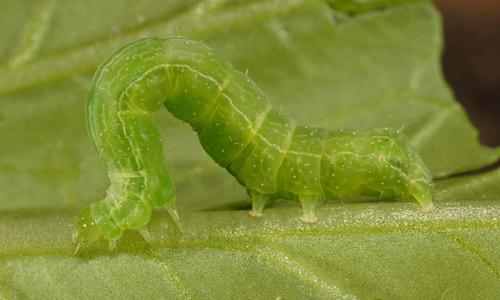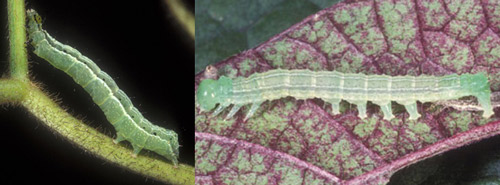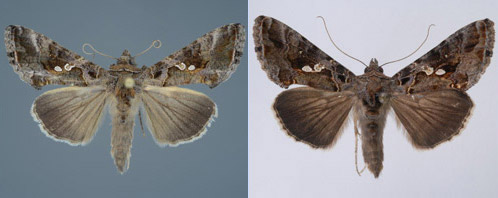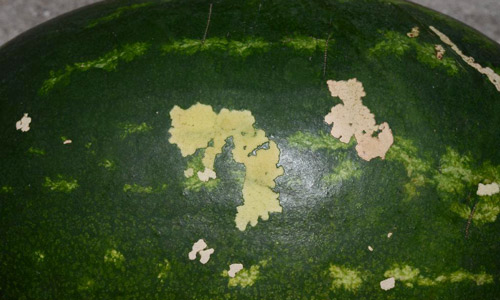common name: soybean looper
scientific name: Chrysodeixis includens (Walker) (Insecta: Lepidoptera: Noctuidae)
Introduction - Distribution - Description and Life Cycle - Hosts - Damage and Economic Importance - Management - Selected References
Introduction (Back to Top)
The soybean looper, Chrysodeixis includens (Walker) (Figure 1), is a light to dark green caterpillar which derives its name from its preferred host plant (soybean, Glycine max) and the looping movement it makes while in motion (Figure 1). It is often confused with the cabbage looper (Trichoplusia ni (Hübner)), which is extremely similar in appearance and size. Although largely a pest of soybean, Chrysodeixis includens feeds on many other agronomic, vegetable, and floricultural crops. Larvae (caterpillars) are known to consume large amounts of foliage and occasionally feed on pods and fruits, while moths feed solely on flower nectar.
Figure 1. Soybean looper larva, Chrysodeixis includens (Walker), making its signature looping motion. Photograph by Lyle J. Buss, University of Florida.
Distribution (Back to Top)
Chrysodeixis includens is an abundant caterpillar feeding on soybean across much of North and South America, and all of Central America. Ranging from Maine to Texas, it is most heavily distributed along the southern and eastern United States, although it is found as far west as California (Herzog 1980). It overwinters only in south Florida and south Texas in the United States, but populations may migrate from Central and South America and the Caribbean Islands (Smith et al.1994, Carner et al. 1974). In the southern United States, populations are most prevalent from August to September (Burleigh 1972, Canerday and Arant 1966).
Description and Life Cycle (Back to Top)
Egg: Chrysodeixis includens undergoes complete metamorphosis, meaning it has egg, larval, pupal, and adult life stages. Females deposit eggs at night in the lower half of the canopy on the underside of leaves (Smith et al. 1994).
Larva: After hatching, the soybean looper usually transitions through six instars, although five to seven instars have been observed (Shour and Sparks 1981). The first instar will last 3-4 days, while most other instars take 2-3 days to complete, with the exception of the final instar, which is 5-6 days (Shour and Sparks 1981). Caterpillars generally feed for 2-3 weeks before pupating.
In its larval stage, the soybean looper is predominantly light to dark green and typically has white stripes running down the dorsal and lateral portions of its body. The body of the soybean looper tends to be thicker and larger at the rear, tapering down towards the head and can reach 1.3 inches (3.03 cm) in length (USDA 2016). Chrysodeixis includens can be differentiated from many similar looking species by inspecting the number of abdominal prolegs. Green caterpillars with three or more abdominal prolegs such as the velvetbean caterpillar, Anticarsia gemmatalis (Hübner), can be easily distinguished from Chrysodeixis includens, which has only two abdominal prolegs (Figure 2). The soybean looper may have black or green thoracic legs, while the cabbage looper has green thoracic legs (Figure 3) (Smith et al. 1994).
Figure 2. Soybean looper larva Chrysodeixis includens (Walker) (left) with two abdominal prolegs, compared to the velvetbean caterpillar Anticarsia gemmatalis (Hübner) (right) with four abdominal prolegs. Photographs by James Castner and Lyle J. Buss, University of Florida.
Figure 3. Soybean looper larva Chrysodeixis includens (Walker) (left) with black thoracic legs compared to the cabbage looper larva Trichoplusia ni (Hübner) (right) with green thoracic legs. Photographs by Lyle J. Buss and James Castner, University of Florida.
Figure 4. Adult soybean loopers, Chrysodeixis includens (Walker), with differing color patterns. Photographs by Lyle J. Buss, University of Florida.
Pupa: Pupation occurs on the underside of leaves, and is completed in 7-9 days with moths emerging during the day (Smith et al. 1994; Shour and Sparks 1981).Pupae are 1/2 inch long (1.27 cm), and range in color from white to green (USDA 2016, Shour and Sparks 1981).
Adult: The adult moth is small, with a wingspan ranging 1 to 1.5 inches (2.54-3.81 cm), and is mottled brown to black in color (USDA 2016). Forewings are darker in color than the hindwings, and possess silvery white spots. Presence of these spots can be used to distinguish the soybean looper from many other crop feeding pests, though it should be noted that the adult cabbage looper also has similar markings.
Hosts (Back to Top)
Chrysodeixis includens is known to consume plant material from many agronomic, vegetable, and ornamental crops. Recorded on 174 plants across 39 plant families, the greatest numbers of plants belong to the families Asteraceae, Solanaceae, Fabaceae, Lamiaceae, Brassicaceae, Poaceae, Amaranthaceae, Euphorbiaceae, and Malvaceae (Specht et al. 2015). They also have a wide range of wild host species, which includes Amaranthus sp., Oxalis sp., kudzu, lantana, groundcherry, and cocklebur, among others (Martin et al. 1976, Specht et al. 2015). Soybean is the preferred host, but it also feeds on other agronomic crops such as peanut, cotton, and corn. Documentation on vegetable crops include peas, crucifers, sweet potatoes, tomatoes, bell peppers, bush beans, cucumber, and watermelon (Canerday and Arant 1966, Martin et al. 1976, Specht et al. 2015). Floriculture crops include African daisy, begonia, carnation, chrysanthemum, geranium, lantana, and sunflower (Specht et al. 2015).
Damage and Economic Importance (Back to Top)
Although it ranges through much of the United States, infestations of economic importance in soybean typically do not occur north of Texas, Arkansas, Mississippi, Alabama, Georgia, and South Carolina (Herzog 1980). Chrysodeixis includens is mainly a foliage feeder, but it will also feed on pods or fruit (Figure 5) (USDA 2016).
Figure 5. Feeding damage from the soybean looper, Chrysodeixis includens (Walker), on a watermelon rind. Photograph by Lyle J. Buss, University of Florida.
Once hatched, the soybean looper feeds in the lower half of the canopy where the egg was laid. The soybean looper has an unusual defoliation pattern, feeding from the lower, inside canopy and then moving up and outwards (Smith et al. 1994). When scouting for pests, this type of feeding pattern can be easily overlooked, as the outer canopy appears undamaged until the top of the plant is defoliated. During early instars when Chrysodeixis includens is small, foliage is not consumed in large amounts as it is by later instars. Most foliage is consumed by the fourth to sixth instars, during the last 4-5 days of the larval stage (Reid and Greene 1973, Trichilo and Mack 1989, Smith et al. 1994).
Management (Back to Top)
Predatory insects that target Chrysodeixis includens during larval development include various true bugs (big-eyed bugs, spined soldier bugs, etc.) and Copidosoma floridanum, a parasitic wasp (Catchot et al. 2014). A study by Burleigh (1972) found seven species of parasitoids that preyed on soybean looper, as well as two fungal pathogens (Spicaria rileyi and Massospora sp.) and a nematode (Mermithidae).
Treatment thresholds vary for this insect based upon the crop being damaged and its current production stage. Soybean for example, is treated prior to bloom when 30% foliage loss has occurred and larvae are present, or after bloom when 15% foliage loss has occurred and larvae are present (Roberts et al. 2017). In contrast, cotton requires approximately five larvae per row foot when the youngest bolls are not mature to trigger an insecticide application (Smith et al. 1994). The threshold commonly used in peanut for foliage feeders is four to eight larvae per row foot, depending on plant age and canopy health (Abney 2017). Floriculture crops would have lower threshold levels based on aesthetic injury.
Bt formulations are commonly used to suppress foliage feeding pests, and do not pose a threat to beneficial insects in the field (Funderburk et al. 1999). Due to the large number of agronomic, vegetable, and floricultural crops that Chrysodeixis includens feeds on, it has developed resistance to many insecticides over time. Resistance has been confirmed for pyrethroid, carbamate, and organophosphate insecticides (Funderburk et al. 1999).
Selected References (Back to Top)
- Abney MR. (2017). Peanut: Peanut insect control. pp 201. In Horton DL (Eds.) Georgia Pest Management Handbook. University of Georgia Extension. (26 May 2020)
- Burleigh JG. 1972. Population dynamics and biotic controls of the soybean looper in Louisiana. Environmental Entomology 1: 290-294.
- Canerday TD, Arant FS. 1966. The looper complex in Alabama (Lepidoptera, Plusiinae). Environmental Entomology 59: 742-743.
- Carner GR, Shepard M, Turnipseed SG. 1974. Seasonal abundance of insect pests of soybeans. Economic Entomology 67: 487-493.
- Catchot A, Layton B, Stewart SD. (2014). Common beneficial arthropods found in field crops. E0020. Mississippi State University Extension. (26 May 2020)
- Funderburk J, McPherson R, Buntin D. 1999. Chapter 15: Soybean insect management. pp. 276-278. In Heatherly L, Hodges H (Eds.) Soybean Production in the Midsouth. CRC Press, Boca Raton, FL.
- Herzog DC 1980. Sampling soybean looper on soybean. pp. 141-168. In Kogan M, Herzog DC (Eds.) Sampling Methods in Soybean Entomology. Springer, New York, USA.
- Martin PB, Lingren PD, Greene GL. 1976. Relative abundance and host preferences of cabbage looper, soybean looper, tobacco budworm, and corn earworm on crops grown in northern Florida. Environmental Entomology 5: 878-882.
- Reid JC, Greene GL. 1973. The soybean looper: Pupal weight, development time, and consumption of soybean foliage. The Florida Entomologist 56: 203-206.
- Roberts P, Toews M, Buntin D. (2017). Soybean: Soybean insect control. pp 232. In Horton DL (Eds.) Georgia Pest Management Handbook. University of Georgia Extension. (26 May 2020)
- Shour MH, Sparks TC. 1981. Biology of the soybean looper Pseudoplusia includens: Characterization of last-stage larvae. Annals of the Entomological Society of America 74: 531-535.
- Smith RH, Freeman B, Foshee W. 1994. Soybean loopers: Late season foliage feeders on cotton. Alabama Extension. Circular ANR-843.
- Specht A, de Paula-Moraes SV, Sosa-Gomez DR. 2015. Host plants of Chrysodeixis includens (Walker) (Lepidoptera, Noctuidae, Plusiinae). Revista Brasileira de Entomologia 59: 343-345.
- Trichilo PJ, Mack TP. 1989. Soybean leaf consumption by the soybean looper (Lepidoptera: Noctuidae) as a function of temperature, instar, and larval weight. Economic Entomology 82: 633-638.
- USDA. (2016). Soybean looper. USDA Agricultural Research Service. (26 May 2020)




